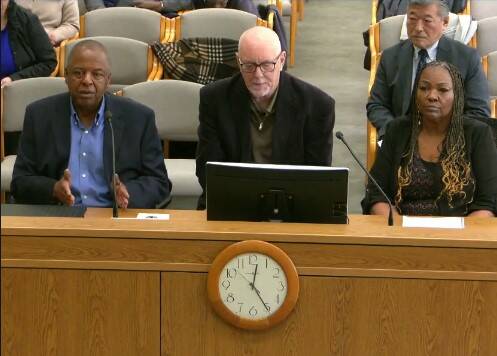There was puppy love in the air at the 4-H Extension Office in Tacoma yesterday – literally.
Guide Dogs for the Blind, Inc. delivered 20 purebred, 2-month-old puppies to volunteer families in order to begin the dogs basic socialization skills, a process which will someday lead to the canines becoming guide dogs for the blind.
We want to thank all you people for taking these puppies, said Michele Cawley, a puppy raising advisor with Guide Dogs for the Blind. It will be quite an adventure.
Those receiving puppies got bags of dog food to take home with them to feed their hungry new charges and an information packet.
As the puppies were handed out to their trainers one-by-one, oohs and aaahs were elicited from the crowd by the adorable puppies.
Cawley herself was the recipient of the first puppy off the van, Orson, a male black Labrador and golden retriever cross, whose new home for the next year will be Ellensburg.
It was a bittersweet day for many of those in attendance, as they were not just picking up new puppies, but parting with dogs they had spent the last year raising.
We brought the Kleenex, just in case, Kim Jasionkowski of Puyallup said.
She and her daughter, Karyn, were saying goodbye to Samara, a yellow Labrador they raised for six months, and picking up Pippin, a female black Labrador.
Puppy raising normally takes about a year, but Jasionkowski described Samara as a challenging dog who was very excitable and had to be returned early.
Those that arent suitable as guide dogs for the blind go on to become pets, guide dogs for the hearing impaired or search and rescue dogs, Cawley explained.
Puppy raisers, with the support of a group leader, teach the puppies obedience, housetraining and social skills by providing home care and direction.
During socialization outings, each puppy is equipped with a special green coat marked Guide Dog Puppy In Training.
This coat allows the puppies to be identified in stores, restaurants, schools, and offices where socialization training takes place.
After about a year, they will return to one of Guide Dogs for the Blinds two campuses in Boring, Ore., or San Rafael, Calif., affectionately referred to as dog college by Cawley.
We socialize them. We teach basic commands and obedience, Jasionkowski said. We enjoy it a lot.
A harness will replace the green puppy coat as the dog begins formal guide training with licensed Guide Dog instructors.
Guide Dogs for the Blind began when Lois and Merrihew and Don Donaldson recognized the need to help wounded servicemen who returned from World War II without their sight. They believed dogs could serve as guides for the blind.
The school was incorporated in May 1942 in Los Gatos, Calif., and in 1947 the school moved to its present location in San Rafael, Calif.
In 1995, the school graduated its first class from a new campus in Boring, Ore.
For more information, please see Guide Dogs for the Blinds Web site at:
www.guidedogs.com.




